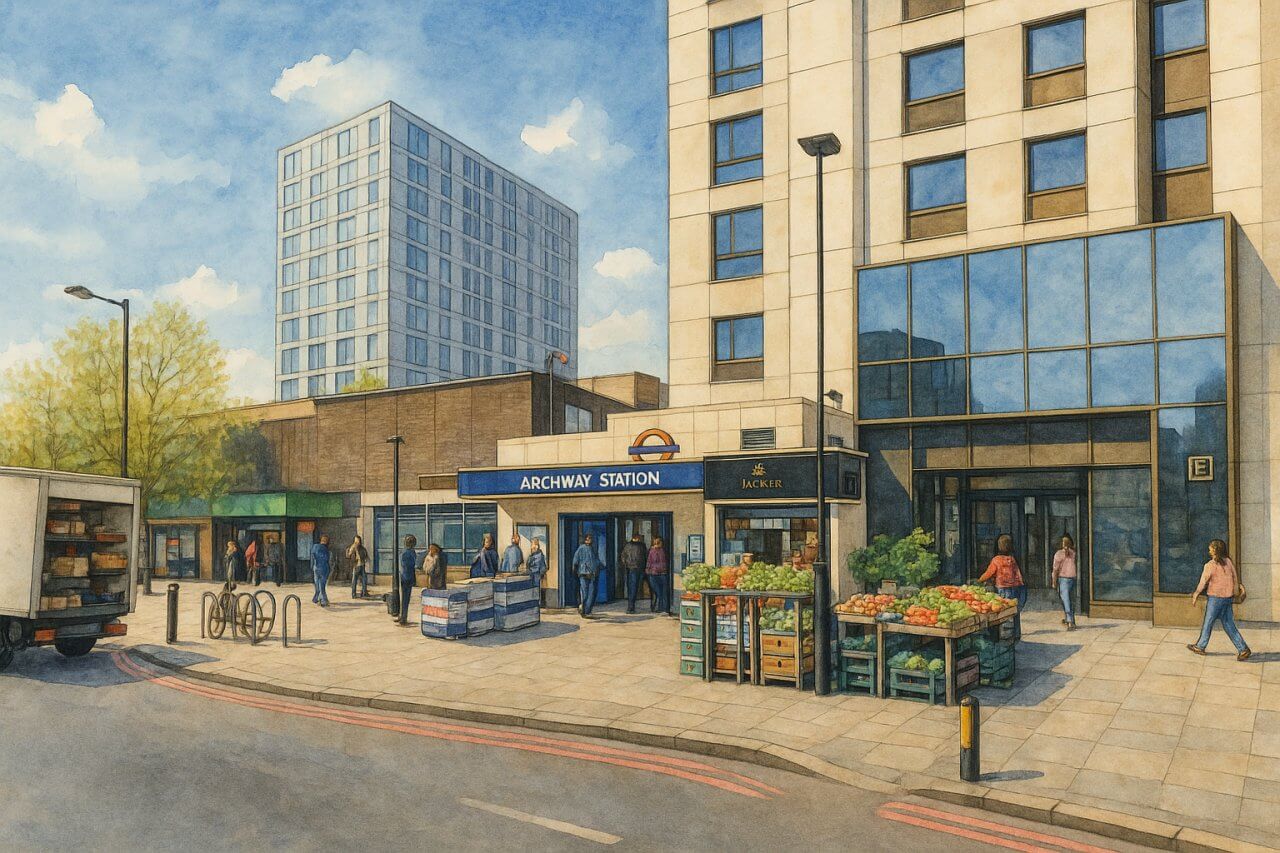
Archway Station, London
Archway Station is a London Underground station on the Northern line, serving the vibrant and diverse community of Archway in the London Borough of Islington. Nestled in North London, this station is a key transit hub for residents and visitors alike, providing fast connections to central London and beyond.
Location and Travel Information
Archway Station is situated at the junction of Junction Road and Highgate Hill, in Islington, North London. It falls within Travelcard Zone 2.
The station lies approximately 4.6 miles (7.4 kilometres) north of Charing Cross by road, making it a relatively short journey into the heart of the capital.
The current adult pay-as-you-go fare from Archway to Charing Cross via the Northern line (changing at Leicester Square) is £2.80 off-peak and £3.60 peak, using an Oyster card or contactless payment1.
History of Archway Station
Archway Station was originally opened on 22 June 1907 by the Charing Cross, Euston & Hampstead Railway, which later became part of the Northern line. At that time, the station was known as Highgate.
The name was changed to Archway (Highgate) in 1939, reflecting the development of the surrounding Archway area and the nearby Archway Road. In 1941, the name was shortened to just Archway, which it has retained ever since2.
Origin and Pronunciation of "Archway"
The name "Archway" originates from the historic Archway Bridge, also known as the Highgate Archway, which was constructed in the early 19th century to carry Hornsey Lane over Archway Road. The station and surrounding area adopted this name due to proximity to the landmark bridge.
"Archway" is pronounced /ˈɑːrtʃweɪ/  , which sounds like “arch-way”, with emphasis on the first syllable.
, which sounds like “arch-way”, with emphasis on the first syllable.
Rail Services at Archway Station
Archway Station is served exclusively by the London Underground. It does not offer services on the Overground, National Rail, or other rail networks. However, its strategic location makes it a vital Northern line station for those commuting to and from North London.
Northern Line Services
Archway is located on the High Barnet branch of the Northern line. The station sits between Tufnell Park (southbound) and Highgate (northbound). Trains from Archway head southbound towards Central London via Camden Town, with some services continuing along the Charing Cross branch to Kennington, and others along the Bank branch to Morden.
- Previous station: Tufnell Park
- Next station: Highgate
Station Design and Accessibility
Archway Station retains many features from its early 20th-century origins, though it has undergone several refurbishments. The original ox-blood red glazed terracotta station façade, a signature of early Underground architecture by Leslie Green, was removed in a 1970s redevelopment, replaced by a more modern structure above ground.
The station has three escalators and one lift, and provides step-free access to the southbound platform only. Northbound access still requires stair use, making the station partially accessible3.
Fun Fact
One of Archway Station’s most curious quirks is the presence of a rarely seen “deep-level air-raid shelter” located beneath the station. This unused section of tunnel was constructed during the Second World War to provide shelter during air raids, though it has never been open to the public4.
Another interesting tidbit: for decades, locals debated the correct name of the station, as the early signage and nearby road names referenced both Highgate and Archway. This ambiguity was only fully resolved when London Transport standardised the name to Archway in the 1940s.
Exploring the Area Around Archway
Archway offers more than just a convenient transport link—it’s a gateway to charming areas like Highgate Village and Waterlow Park. The station also provides access to Whittington Hospital, located a short walk away, and serves as a transit point for those heading towards Hampstead Heath and beyond.
Local buses such as the 43, 134, and 271 operate from the nearby bus interchange, making Archway a multi-modal connection hub in North London.
Quick Facts
- Station Name: Archway
- Borough: London Borough of Islington
- Travelcard Zone: Zone 2
- Distance from Charing Cross: Approximately 4.6 miles (7.4 km)
- Fare to Charing Cross: £2.80 (off-peak), £3.60 (peak) with Oyster/contactless
- Opening Date: 22 June 1907
- Original Name: Highgate
- Renamed: Archway (Highgate) in 1939, Archway in 1941
- Pronunciation: “Arch-way” /ˈɑːrtʃweɪ/
- Rail Services: London Underground (Northern line)
- Preceding Station: Tufnell Park
- Following Station: Highgate
- Accessibility: Step-free access to southbound platform only
- Fun Fact: WWII-era air-raid shelter exists beneath the station
References
- TfL: Tube and Rail Pay-as-you-go fares
- London Transport Museum: Archway Station
- TfL Step-Free Access Guide
- Subterranea Britannica: Archway Deep Level Shelter
Archway Station is  on the Map of London Underground
on the Map of London Underground

Painting of Archway Station, London (View image in full size)